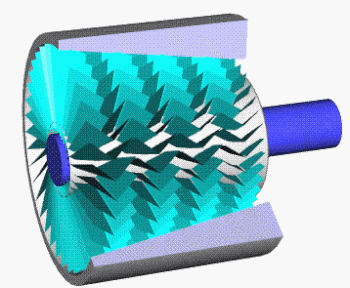
Back ضاغط محوري Arabic Compressor axial Catalan Compresor axial Spanish کمپرسور محوری Persian Compresseur axial French Compressore assiale Italian 軸流式圧縮機 Japanese Axiale compressor Dutch Sprężarka osiowa Polish Axialkompressor Swedish

An axial compressor is a gas compressor that can continuously pressurize gases. It is a rotating, airfoil-based compressor in which the gas or working fluid principally flows parallel to the axis of rotation, or axially. This differs from other rotating compressors such as centrifugal compressor, axi-centrifugal compressors and mixed-flow compressors where the fluid flow will include a "radial component" through the compressor.
The energy level of the fluid increases as it flows through the compressor due to the action of the rotor blades which exert a torque on the fluid. The stationary blades slow the fluid, converting the circumferential component of flow into pressure. Compressors are typically driven by an electric motor or a steam or a gas turbine.[1]
Axial flow compressors produce a continuous flow of compressed gas, and have the benefits of high efficiency and large mass flow rate, particularly in relation to their size and cross-section. They do, however, require several rows of airfoils to achieve a large pressure rise, making them complex and expensive relative to other designs (e.g. centrifugal compressors).
Axial compressors are integral to the design of large gas turbines such as jet engines, high speed ship engines, and small scale power stations. They are also used in industrial applications such as large volume air separation plants, blast furnace air, fluid catalytic cracking air, and propane dehydrogenation. Due to high performance, high reliability and flexible operation during the flight envelope, they are also used in aerospace rocket engines, as fuel pumps and in other critical high volume applications.[2]
| Typical application | Type of flow | Pressure ratio per stage | Efficiency per stage[2] |
|---|---|---|---|
| Industrial | Subsonic | 1.05–1.2 | 88–92% |
| Aerospace | Transonic | 1.15–1.6 | 80–85% |
| Research | Supersonic | 1.8–2.2 | 75–85% |
- ^ Yahya, S.M. (2011). Turbines, Compressors and Fans. Tata McGraw Hill Education Private Limited. ISBN 978-0-07-070702-3.
- ^ a b Meherwan, P.Boyce. "2.0 Axial Flow Compressors".
© MMXXIII Rich X Search. We shall prevail. All rights reserved. Rich X Search